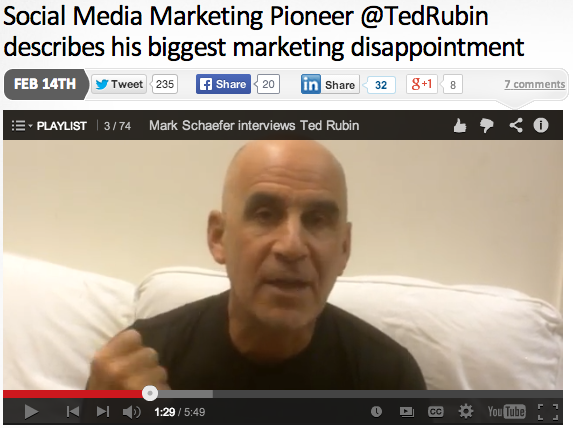Originally posted at BusinessGrow.com
Ted Rubin has been on the forefront of social media marketing innovation but when I asked him what was his exciting him about the future, he had a very surprising answer. I liked the conversation so much that I knew I needed to record it for all my friends on {grow}! It’s a short interview but Ted talks fast so he covers a lot of ground, including:
– Disconnect between agency pitches and business needs
– The glacial rate of social media change at the enterprise level
– The number one reason social media is not being spread to employees
– The need for a small-town mentality on the web
I’m sure you’ll enjoy this discussion. Let me know what you think in the comment section below!

 Big Data is a popular term today that references the huge volumes of business and consumer data being collected and stored by organizations, which cannot be effectively data mined due to the limitations of commonly used software tools that capture, manage, or process the data.
Big Data is a popular term today that references the huge volumes of business and consumer data being collected and stored by organizations, which cannot be effectively data mined due to the limitations of commonly used software tools that capture, manage, or process the data. Social Marketing is the ultimate in Permission Marketing, and therefore it carries the ultimate marketing danger with it: taking away the permission is totally in the consumers’ control. Brands be(a)ware!
Social Marketing is the ultimate in Permission Marketing, and therefore it carries the ultimate marketing danger with it: taking away the permission is totally in the consumers’ control. Brands be(a)ware! This is the first part in a short series to introduce
This is the first part in a short series to introduce  It’s inevitable that in many discussions of social media and social business development, someone will ask:
It’s inevitable that in many discussions of social media and social business development, someone will ask: If necessity is the mother of invention, then perhaps imagination is the source of innovation.
If necessity is the mother of invention, then perhaps imagination is the source of innovation. Building something entirely new. Creating something fresh from something that existed. Evolving business to a new place. Changing a culture. True innovation. Standout success. Attaining influence or authority. Building a devoted following. Creating lasting relationships.
Building something entirely new. Creating something fresh from something that existed. Evolving business to a new place. Changing a culture. True innovation. Standout success. Attaining influence or authority. Building a devoted following. Creating lasting relationships.